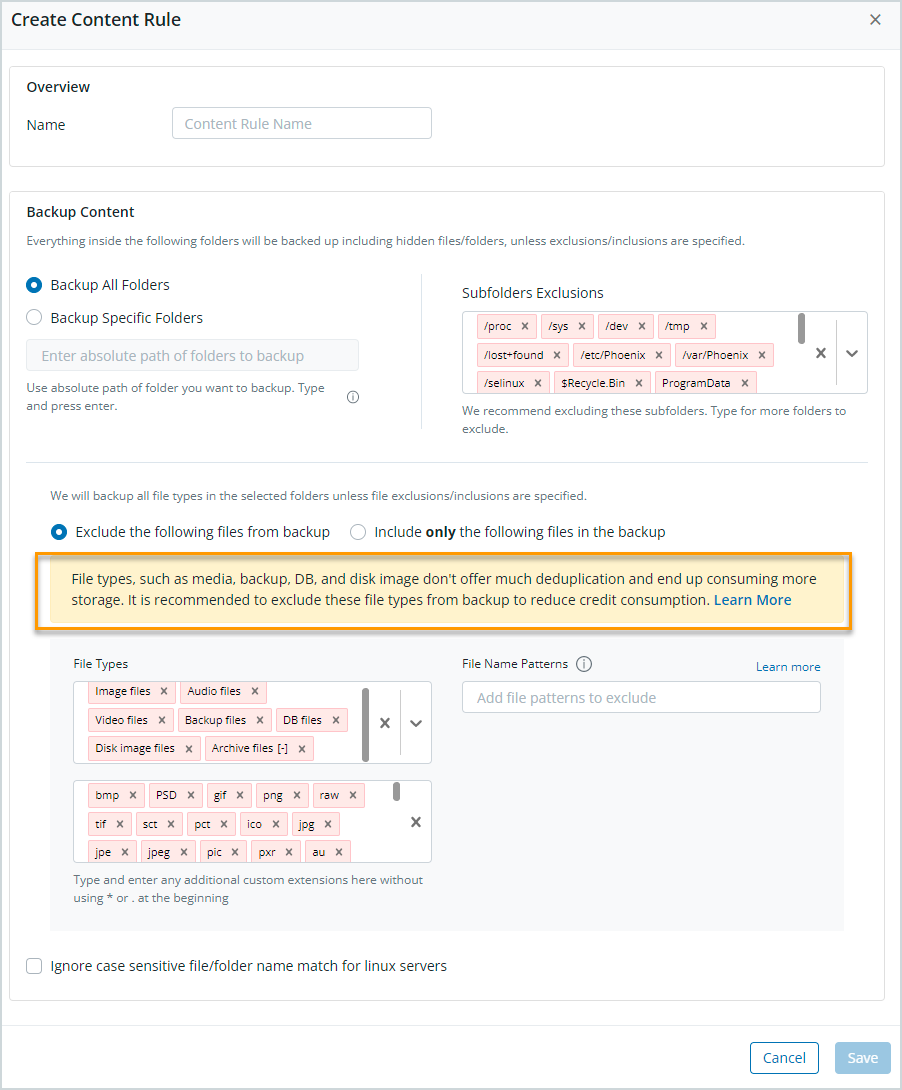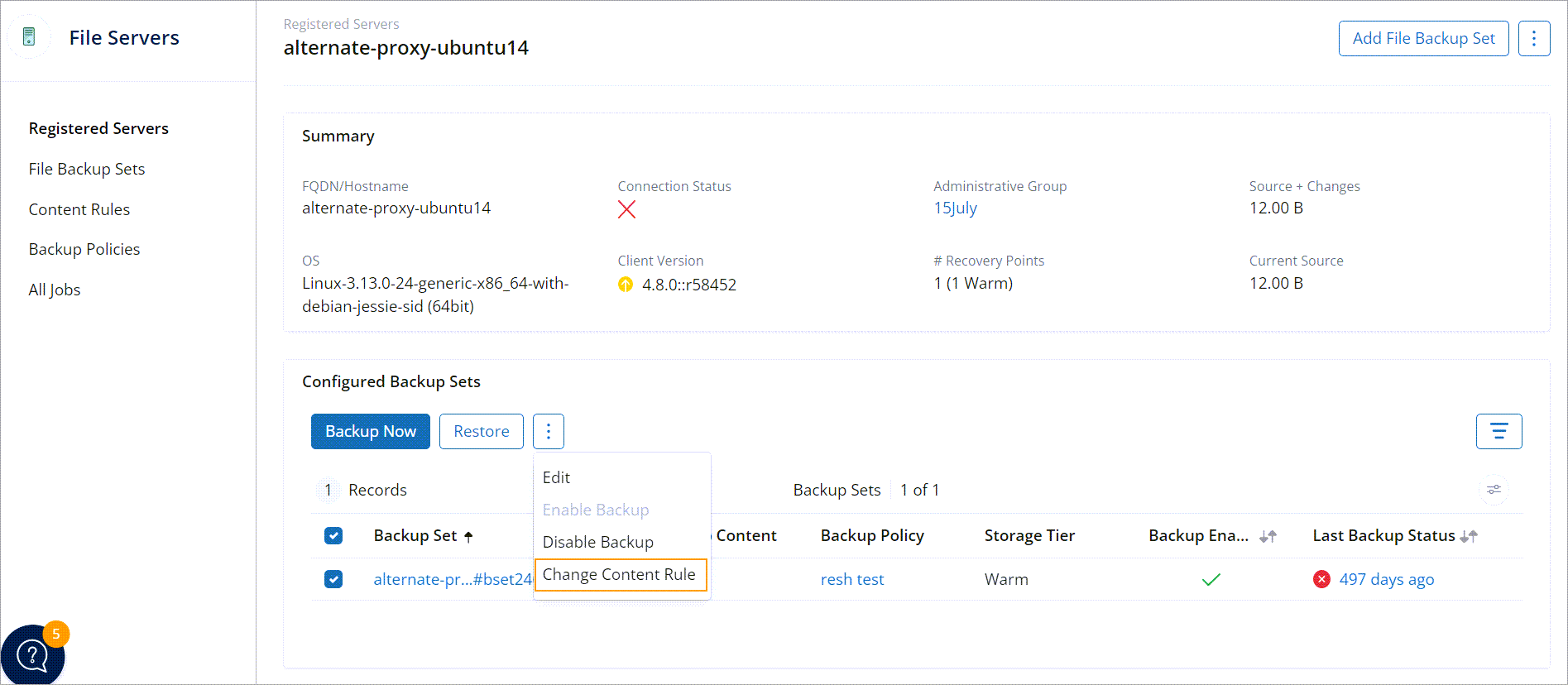Manage content rules
 Business
Business  Enterprise
Enterprise  Elite
Elite
This topic describes the following sections:
- Overview
- Best practices to create content rule
- Add a content rule
- View content rule
- Edit a content rule
- Delete a File server content rule
- Change Content Rule
Overview
Content rules define the data to be backed up. You can create a custom rule and attach it to one or more servers. After you assign the servers to backup sets, data from these servers is backed up according to the content rule and backup policy defined in the backup set.
Druva creates a default content rule for your setup. The default content rule is configured to back up all folders excluding a few system folders. The default content rule also excludes image, audio, video, executable, database, backup, and disk image file types from backups. You can assign the default content rule to one or more servers. You can also update or delete this content rule.
Note: The Manage Content Rules page do not list the custom content.
Best practices to create content rule
- Create a content rule when you have multiple backup sets on different servers, which need to backup the same content.
- Save the content rule based on its backup content. For example, you can save the content rule that backs up files at the C:/Docs and D:/ locations, as C_docs_D.
- Do not apply overlapping backup content to different backup sets of the same server. This will unnecessarily back up the same content as a part of the different backup sets.
Add a content rule
You can create a content rule for a File server. You cannot configure a server with multiple backup sets having the same backup content.
Before you begin
Before adding a content rule for File servers, ensure you have read:
- The Default folder exclusions to know the default folder types that Druva excludes from the backup.
- The Default file types for backup to know the file types that Druva supports.
Procedure
- Log in to the Management Console.
- Select the workload from the Protect menu. Note that if the All Organizations menu is enabled, you have to first select an organization and then select the workload.
- In the left pane, click Content Rules.
- Click Create Content Rule. This brings up the Create Content Rule window.
- In the Overview section, in the Name field, enter a name for this content rule.
- Under the Backup Content section, perform the following tasks:

| Field | Description |
|---|---|
| Backup All Folders | Select this option if you want to backup all files and folders, including hidden files and folders. The folders under Subfolder Exclusions are excluded from backups. |
| Backup Specific Folders |
Select this option to backup specific folders. Type the absolute path (including the root directory) of the folder in the corresponding box and press Enter. You can also click Add <entered folder path> to add the folder. Use the following formats while entering absolute paths:
|
| Subfolder Exclusions |
Druva excludes a few folders from backup by default. For more information on the folders excluded by default in Windows and Linux, see Folders excluded from File server backup. The subfolder exclusions apply whether you choose to backup all folders or specific folders. To exclude more subfolders, type their absolute or relative path, and press Enter. To remove a subfolder from this list, click the cross icon next to the path. Sub-folder exclusions support the following wildcard patterns: Wildcards without existing paths
Wildcards with existing paths
The file extension is considered as part of the filename.
|
|
Specify File Exclusions or Inclusions If this option isn’t selected all file types, file extensions, and file patterns in the folders selected under Backup Content are backed up. |
|
| Exclude the following files from backup |
Exclude the specified file types and file patterns from the folders selected above.
If you remove any file type that is excluded from backup, a pop-up message is displayed on the screen.
|
| Include only the following files in the backup | Include the specified file types and file patterns from the folders selected above. |
| File Types | Select file types to exclude/include Select predefined file types that must be excluded from or included in the backup of folders specified under Backup Content. |
|
Enter the extensions to exclude/include This field displays the file extensions associated with the selected file types. You can enter custom extensions if you do not find your extensions under any predefined file types.
|
|
| File Name Patterns |
Enter file patterns that must be excluded from or included in the backup of folders specified under Backup Content. File patterns start with a * and can contain * *.string* or *.*string in the pattern string. Enter patterns like *.ext in the format ext in the file extension field under File Types.
|
| Ignore case sensitive file/folder name match for Linux servers |
By default, this option is deselected. With this option deselected, the file and folder names entered in the Backup Specific Folders, Subfolder Exclusions, File extensions, and File Patterns fields are accepted as is, in whatever case you enter them. For Linux servers, this means that the entered text is case-sensitive. If this option is selected, Druva ignores the case of the files and folder names in these fields. For Linux servers, this means that the entered text becomes case-insensitive.
|
-
Click Save.
Note: The Save button is disabled if:
You select Specify Custom Content and then Backup Specific Folders but don't enter any absolute folder paths.
You don't enter a content rule name.
You enter an unsupported file extension or file pattern.
Correct the error and then click Save.
The created content rule now appears on the Content Rules page.
View content rule
To view the list of content rules created for the File Servers, perform the following tasks:
- Log in to the Management Console.
- Select the workload from the Protect menu. Note that if the All Organizations menu is enabled, you have to first select an organization and then select the workload.
- In the left pane, click Content Rules. The right pane displays the available content rules. Hovering over the values under the Backup Content column displays the list of all folders excluded from or included in the backup for the corresponding content rule. It also displays the included or excluded file types, and file patterns.

- Click the content rule to view its details. The content rule details page provides the summary and server details of the content rule.
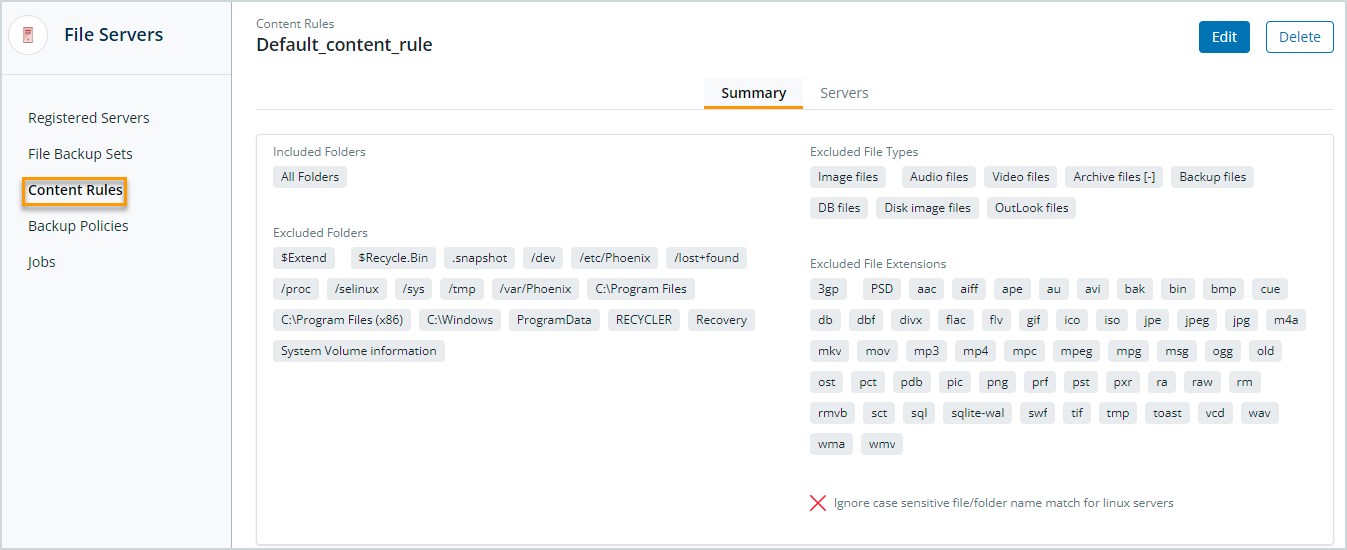
For more information about the details, see Manage Content Rules details page.
Edit a content rule
When you edit a content rule, the updated configurations apply to all backup sets associated with that content rule. The updates are effective from the next backup of the corresponding backup sets. However, you can edit custom content applied to a certain server, and the updated configurations apply only to the associated backup set. The updates are effective from the next backup of the backup set.
- Log in to the Management Console.
- Select the workload from the Protect menu. Note that if the All Organizations menu is enabled, you have to first select an organization and then select the workload.
- In the left pane, click Content Rules. The right pane displays the available content rules.
- Click the content rule that you want to modify.
- In the Content Rules details page, click Edit.
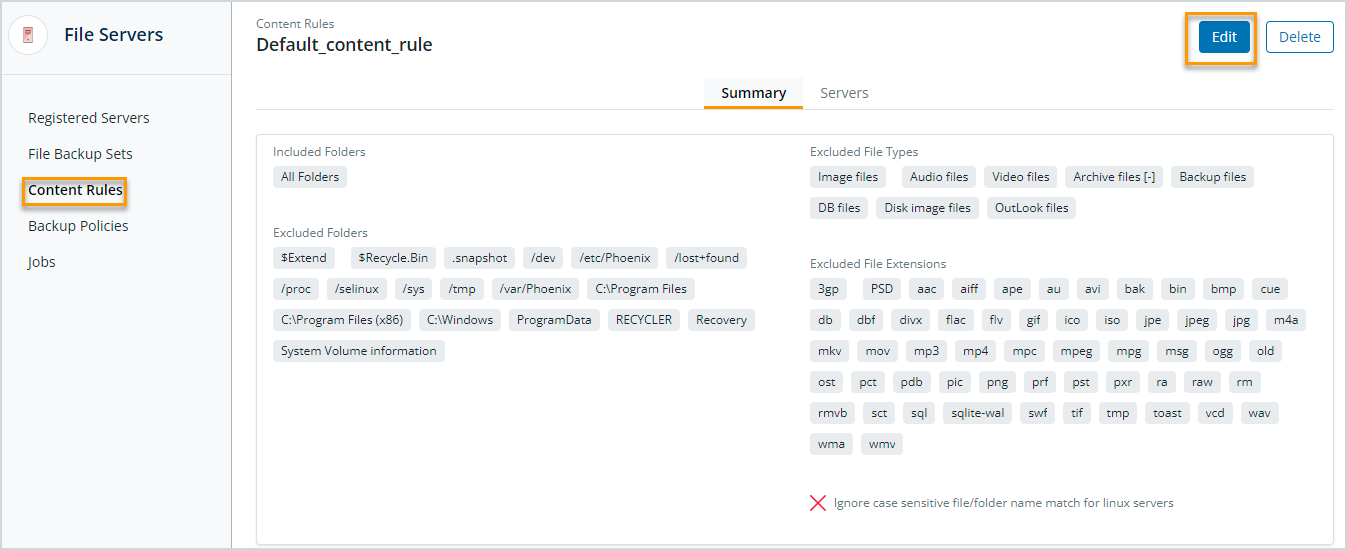
- In the Edit Content Rule dialog box, you can edit the content rule name, backup content, and file inclusions or exclusions. You can also choose to either select or deselect the Ignore case sensitive file/folder name match for linux servers option. For detailed field descriptions, see Add a content rule.
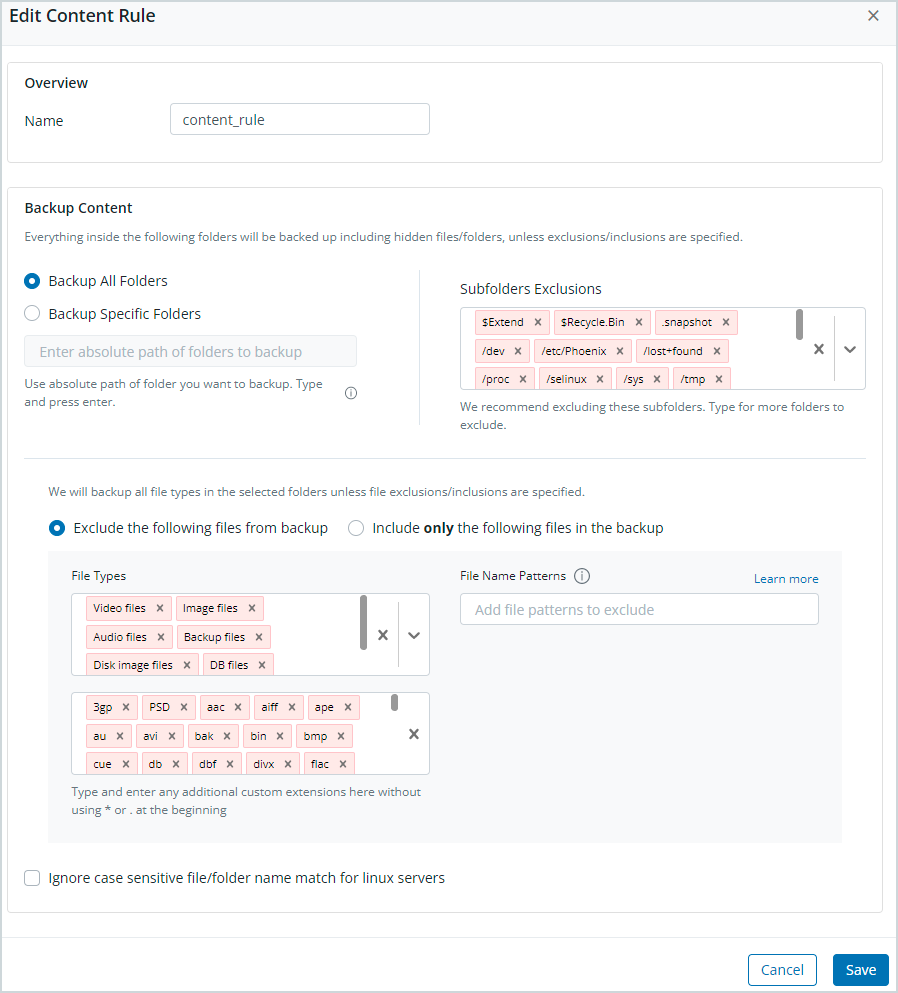
- Click Save.
Note: The Save button is disabled if:
- You select Specify Custom Content and then Backup Specific Folders but don't enter any absolute folder paths.
You don't enter a content rule name.
You enter an unsupported file extension or file pattern.
Correct the error and then click Save.
Delete a content rule
You can delete a File server content rule that you no longer need. You cannot delete a content rule mapped to one or more backup sets.
Note: You can delete a content rule only after 7 days of the deletion of the last backup set mapped to the rule.
Procedure
- Log in to Management Console.
- Select the workload from the Protect menu. Note that if the All Organizations menu is enabled, you have to first select an organization and then select the workload.
- In the left pane, click Content Rules.
- Click the content rule that you want to delete.
- In the Content Rules details page, click Delete.

Note: A content rule mapped to one or more servers cannot be deleted. To see which servers are associated with the content rule, click the Servers tab on the Content Rules details page. Associate these servers with other content rules, and then delete the content rule. To change the content rule for the servers, from the Servers tab, click the server name. From the server details page, select the backup set, click more options, and select Change Content Rule. For more information, see Change Content Rule.
Change Content Rule
Druva allows you to apply the same content rule to backup sets of multiple servers. However, one content rule can only apply to one backup set on a server.
- Log in to Management Console.
- Select the workload from the Protect menu. Note that if the All Organizations menu is enabled, you have to first select an organization and then select the workload.
- In the left pane, click File Backup Sets.
- In the right pane, select one or more backup sets for whom you want to change the content rule. Click Change Content Rule.

- In the Change Content Rule dialog box, select the content rule that needs to be associated with all the selected backup sets. The Content Rule Details section in the Change Content Rule window, displays a summary of all the included and excluded content. Verify the content, and click Save.
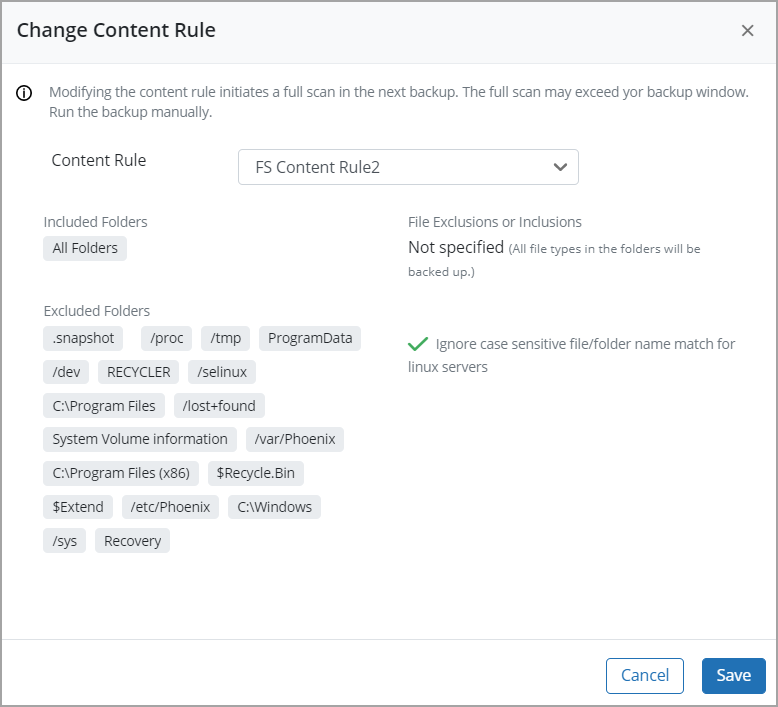
Note: Modifying the content rule initiates a full scan in the next backup. The full scan may exceed your backup window. Use Backup Now to run a manual backup of all the selected backup sets that will be modified as a result of this change.
33772


